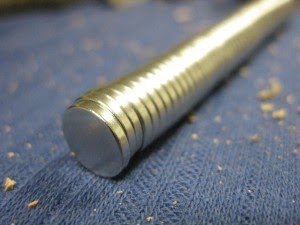Materials needed:
Oak Wine Corks
DrillGlue
Magnets
This is a messy project because of the cork that will be removed with the drill, so I would definitely cover an area, or do this project outside. Let’s get started…
First decide which side of your oak cork you would like to be the front of the magnet. You will drill a hole for the magnet on the opposite side. The size of the drill bit doesn’t really matter (unless it is better than your magnet). You are going to use the drill to dig out a shallow hole the size of the magnet.
Don’t worry the holes don’t have to be perfectly circular or anything special. As you dig out the cork with the drill you can stop and check to see if the magnet is fitting. You want the magnet to fit in flush with the cork. If you drill or dig too deeply into the cork, don’t worry either, that’s what the glue is for. I use both sides of an old paint brush to help get extra pieces of cork out of the way as I’m drilling.
Magnets
There are several magnets you can use. I selected Neodymium Rare Earth Magnets, size 3/8 x 1/16. I purchased a set from a cute little Etsy shop. Each little magnet can pull a little over 2 pounds and holds down several sheets of paper . What is important in magnet selection, is that they are stronger enough to hold what you would like, and small enough to fit nicely into your cork.
Glue
Now, we are ready to glue. I would recommend an industrial strength glue, like E-6000. It dries clear and is strong enough to hold the magnet to the cork while it is in use. I also like it because E-6000 is waterproof, non-flammable and washes off my hands easily. Just fill the drilled hole with glue and place the magnet in the center. If some glue oozes out or gets on the magnet, don’t worry it will peel off the metal when it is dry.
It is important to note here that the magnets will attract to each other while you are doing this project. Once glue has entered the picture, I would keep the corks with magnets drying in them, far away from other corks with magnets drying in them! I used some wood molding sticks to separate them, but you can use plates, cups, Tupperware, anything that would help separate the corks while keeping them face down to dry. E-6000 recommends you let the glue dry 24-72 hours. I found after 24 hours all was dry and ready for use.
This project allows you to showcase special wine corks. Like corks that are from a rare bottle of wine on a special anniversary, or unique corks that have pretty markings. I like to use oak wine corks that have natural wine staining on the ends.
Happy Crafting!
And of course, if you would like to me to make you a set, just hop on over to our shop!







Looks great. Thank you!
ReplyDeleteI knew that I was hanging on to all those corks for a reason!
ReplyDeleteThanks, Bee
Wonderful! Thanks Bee!
ReplyDelete